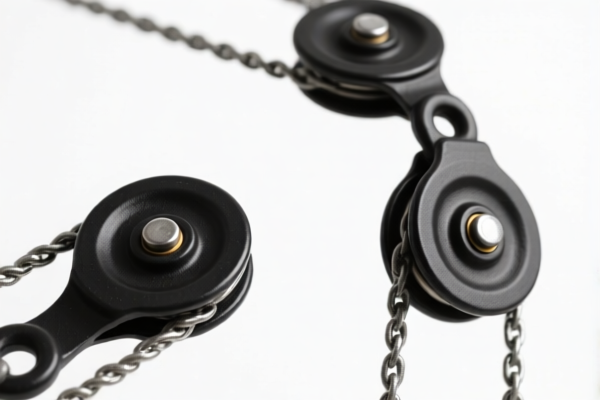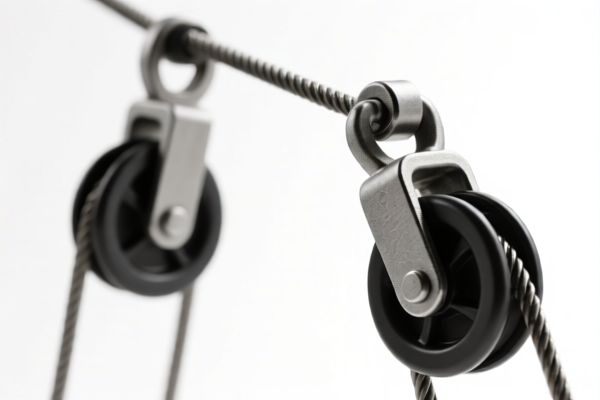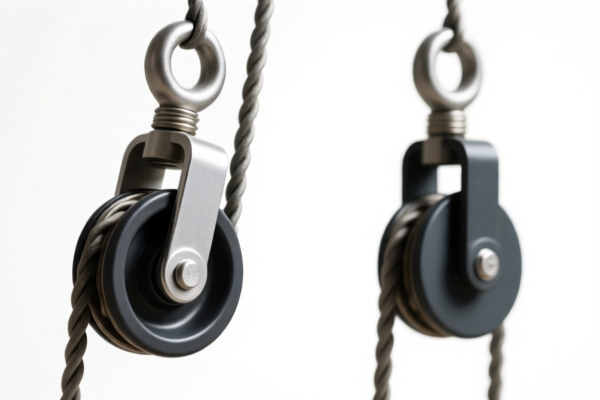| HS Code | Official Doc | Tariff Rate | Origin | Destination | Effective Date |
|---|---|---|---|---|---|
| 8425110000 | Doc | 55.0% | CN | US | 2025-05-12 |
| 8425190000 | Doc | 55.0% | CN | US | 2025-05-12 |
| 8431499005 | Doc | 80.0% | CN | US | 2025-05-12 |
| 8431499044 | Doc | 80.0% | CN | US | 2025-05-12 |
| 8483504000 | Doc | 60.7% | CN | US | 2025-05-12 |
| 8483506000 | Doc | 57.8% | CN | US | 2025-05-12 |
| 7315895000 | Doc | 83.9% | CN | US | 2025-05-12 |
| 7315810000 | Doc | 80.0% | CN | US | 2025-05-12 |
| 7312100500 | Doc | 80.0% | CN | US | 2025-05-12 |
| 7312107000 | Doc | 80.0% | CN | US | 2025-05-12 |




Lifting Pulley
A lifting pulley, also known as a block and tackle, is a simple machine used to lift heavy loads with less force. It consists of one or more wheels (sheaves) with a rope, cable, or chain wrapped around them.
Material:
- Sheaves: Commonly made of steel, aluminum, or durable polymers. Steel is preferred for high-load applications due to its strength. Aluminum is used where weight reduction is important.
- Rope/Cable/Chain: Materials vary based on load and environment.
- Steel Cable: High strength, used for heavy industrial lifting.
- Synthetic Rope (Nylon, Polyester, Dyneema): Lighter, resistant to corrosion, suitable for many applications.
- Chain: Durable, reliable, often used in hoists and industrial settings.
- Frame/Housing: Steel or aluminum are common, providing structural support.
Purpose:
The primary purpose of a lifting pulley is to reduce the amount of force needed to lift a load. This is achieved by distributing the weight of the load over multiple rope sections. It also allows for changes in the direction of force, making lifting easier and more convenient.
Function:
A lifting pulley works based on the principle of mechanical advantage. The mechanical advantage is determined by the number of rope sections supporting the load. For example:
- Single Pulley: Changes the direction of force but does not reduce the force required (mechanical advantage = 1).
- Double Pulley (with 2 supporting ropes): Reduces the force required by half, but the rope must be pulled twice the distance.
- Multiple Pulleys: Increasing the number of supporting rope sections further reduces the force needed, but proportionally increases the distance the rope must be pulled.
Usage Scenarios:
- Construction: Lifting building materials (steel beams, concrete blocks, etc.).
- Warehousing & Logistics: Moving heavy pallets and goods.
- Manufacturing: Lifting and positioning components during assembly.
- Automotive Repair: Lifting engines and other heavy parts.
- Marine Applications: Raising and lowering sails, anchors, and other equipment.
- Gyms & Fitness: Used in cable machines for weight training.
- Home Use: Raising and lowering items in garages or workshops.
Common Types:
- Single Fixed Pulley: Changes the direction of force only.
- Single Movable Pulley: Reduces the force required, but increases the distance.
- Block and Tackle Systems: Combine fixed and movable pulleys for greater mechanical advantage. These are often rated by the number of parts of rope supporting the load (e.g., 3:1, 4:1, 5:1).
- Chain Hoists: Utilize chain instead of rope, offering high durability and load capacity. Often manually operated or powered.
- Wire Rope Hoists: Use steel wire rope and are commonly found in industrial settings.
- Lever Hoists (Come-alongs): Use a lever to pull a cable, providing a compact and portable lifting solution.
- Electric Hoists: Powered by an electric motor, offering convenient and efficient lifting for heavy loads.
Lifting pulleys fall under several classifications depending on their power source and specific application. Here's a breakdown of relevant HS codes based on the provided information:
- 8425110000: This code covers pulley tackle and hoists (excluding skip hoists) powered by an electric motor. This classification applies to electrically powered lifting pulleys. Chapter 84 relates to nuclear reactors, boilers, machinery and mechanical appliances; Heading 8425 specifically addresses pulley tackle and hoists; Subheading 842511 further defines this as powered by electric motor. The total tax rate is 55.0%.
- 8425190000: This code encompasses pulley tackle and hoists (excluding skip hoists or those used for raising vehicles) that are not powered by an electric motor. This would include manual or other non-electric powered lifting pulleys. Chapter 84 relates to nuclear reactors, boilers, machinery and mechanical appliances; Heading 8425 specifically addresses pulley tackle and hoists; Subheading 842519 further defines this as 'other' types. The total tax rate is 55.0%.
- 8483504000: This code covers gray-iron awning or tackle pulleys not over 6.4 cm in wheel diameter. Chapter 84 relates to nuclear reactors, boilers, machinery and mechanical appliances; Heading 8483 specifically addresses transmission shafts, bearings, gears, and pulleys; Subheading 8483504000 further defines this as gray-iron awning or tackle pulleys with a wheel diameter of 6.4 cm or less. The total tax rate is 60.7%.
- 8483506000: This code covers other flywheels and pulleys, including pulley blocks. Chapter 84 relates to nuclear reactors, boilers, machinery and mechanical appliances; Heading 8483 specifically addresses transmission shafts, bearings, gears, and pulleys; Subheading 8483506000 further defines this as 'other' flywheels and pulleys. The total tax rate is 57.8%.
Regarding HS code 8431499005 and 8431499044, these codes relate to attachments for mounting on machinery, specifically backhoe attachments and parts of backhoes, shovels, clamshells and draglines. These codes may be relevant if the lifting pulley is part of a larger backhoe or excavation system. The total tax rate is 80.0%.
Regarding HS code 7315895000, 7315810000, 7312100500 and 7312107000, these codes relate to chain and parts thereof, of iron or steel. These codes may be relevant if the lifting pulley uses chain as a lifting medium. The total tax rate is 83.9% and 80.0%.
Please note that for HS codes 8431499005 and 8431499044, verification of the material (steel, aluminum) is required, and a 25% additional tariff applies to steel and aluminum products. For HS codes 7315895000, 7315810000, 7312100500 and 7312107000, a 25% additional tariff applies to steel and aluminum products.
Customer Reviews
No reviews yet.